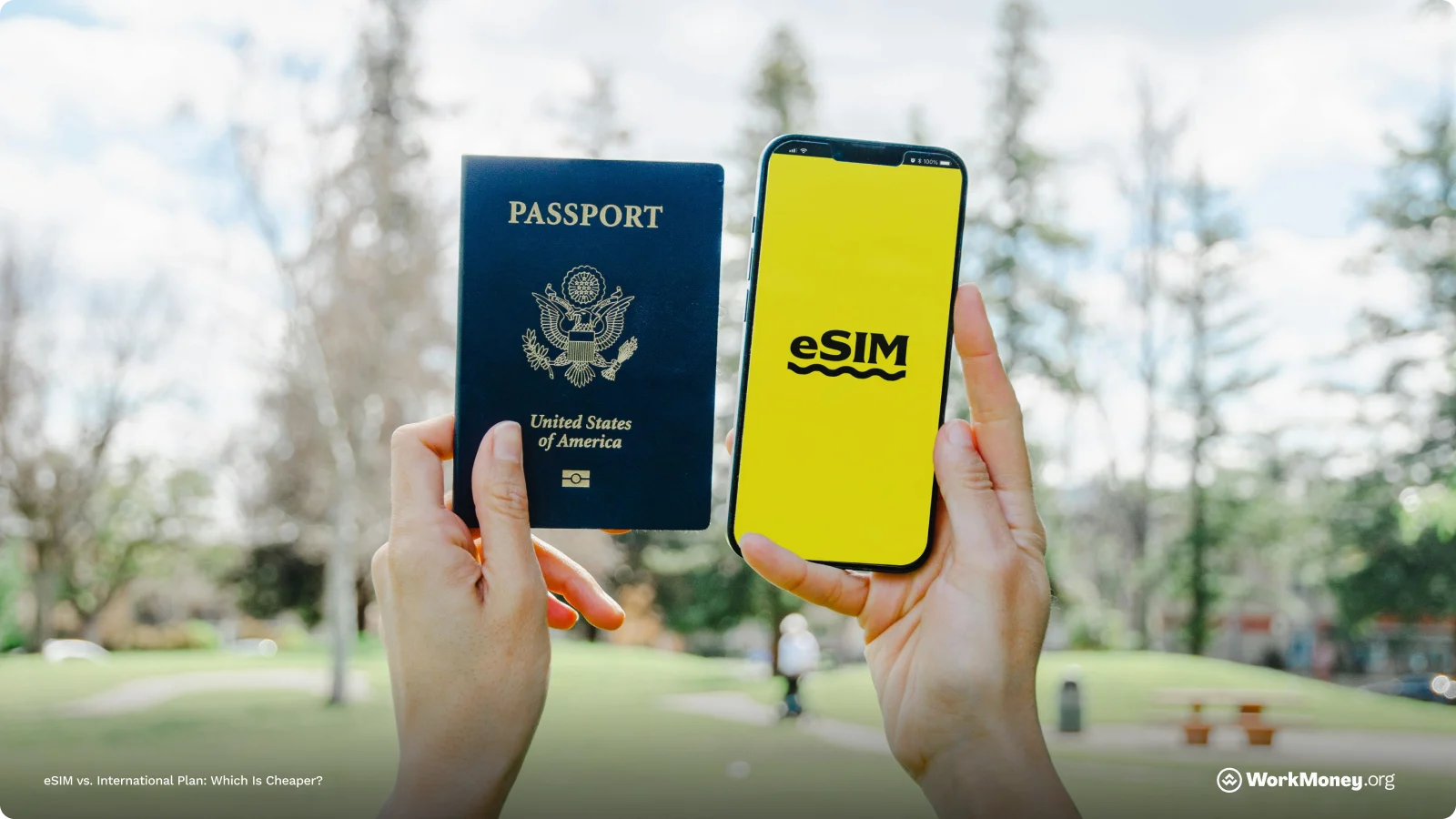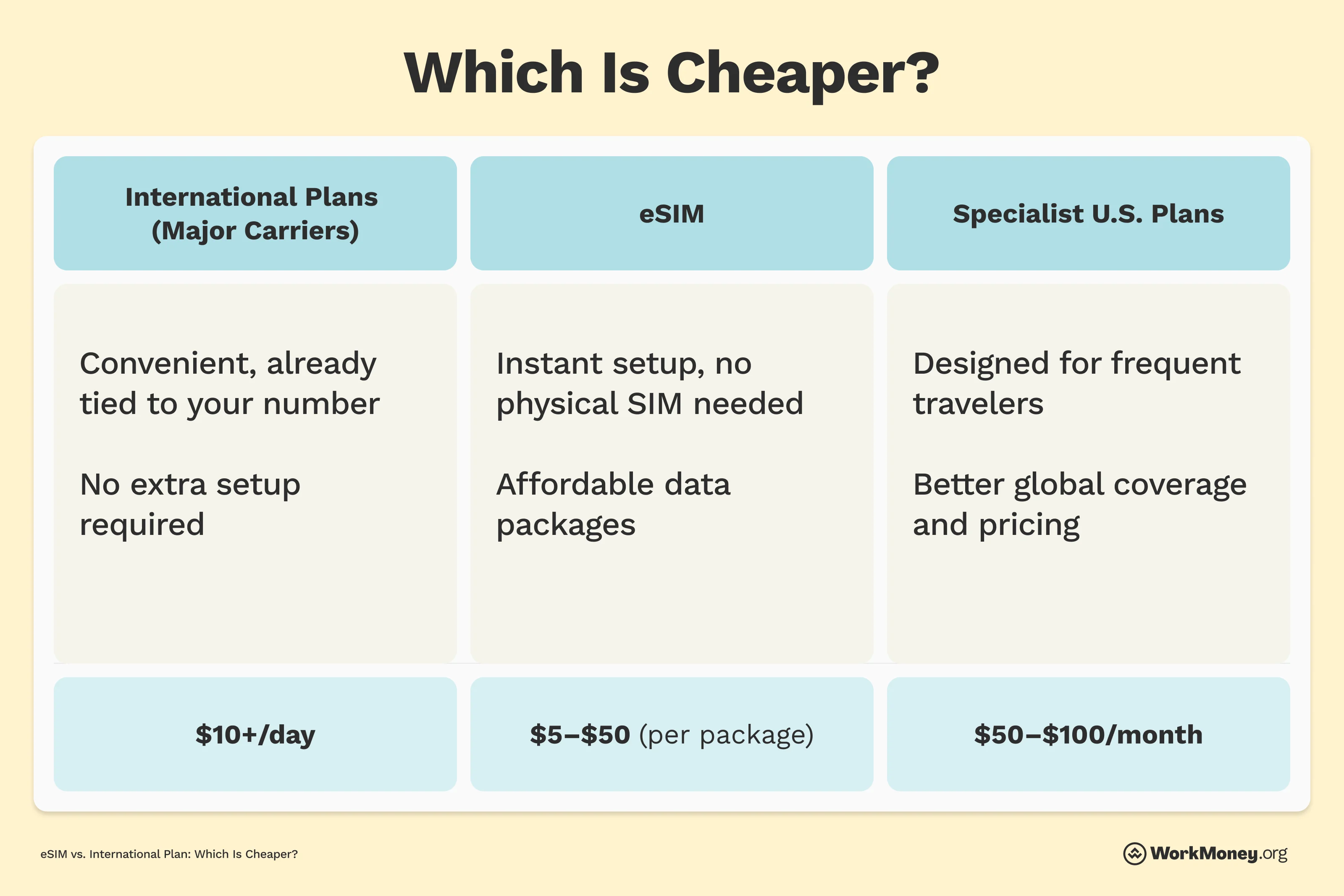eSIM vs. International Plan: Which Is Cheaper?
Don't come home to a huge phone bill. A simple guide to the cheapest way to stay connected abroad.

If you’ve ever come home from an international trip only to open your phone bill and feel your stomach drop, you’re not alone. Many travelers discover hundreds—or even thousands—of dollars in unexpected charges.
That sticker shock comes from data roaming—the extra fees your cellphone provider adds when you use your phone outside its normal coverage area.
Fortunately, you don’t have to pay sky-high roaming fees to stay connected. The WorkMoney team breaks down your options and shows you the cheapest ways to use your phone overseas—so you can keep in touch while you’re away, without blowing your budget.

The Problem With International Phone Plans
Before we get into the details, let’s clarify some tech jargon you’ll see in this article.
An eSIM is just a digital version of a SIM card.
Instead of swapping out the tiny plastic chip in your phone, you can download an eSIM directly to your device in just minutes. Think of it as the same thing you already use—just without the physical card.
Without this, your carrier will automatically switch you to their international plan, which could be pricey.
💡 WorkMoney Tip: Download and set up your eSIM before you leave home. So it’s ready to go the moment you land—no scrambling for Wi-Fi abroad.
Cost Comparison – Which Saves the Most?
Here’s a simple way to see the differences. Check out the following example of using each plan type for one week in Mexico. The actual prices may vary by destination and plan choice.
Cost Per Week (Example: Mexico)
Option | 1-Week Estimate | Details |
Carrier International Plan | ~$42/week | Example uses Verizon TravelPass at $6/day in Mexico (7×$6) |
Travel eSIM | ~$18–$20/week | Example: Airalo Mexico 5GB/30-day plan typically ~$18.50; you’d use it for the week. Data-only; use apps for calls. |
Specialist Plan (Ultra Mobile) | ~$12/week | Unlimited plan $49/mo, which includes a 5GB Mexico Data Roaming Pass each month (49/4 ≈ $12.25) |
WorkMoney Take: For a single short trip, a travel eSIM usually costs less. If you travel frequently or make regular international calls, a specialist plan often proves more cost-effective over time.
How to Choose the Best Option for Your Trip
Not sure where to start? Use these quick scenarios to match your trip with the right plan.
Quick Scenarios
Short vacation (up to ~10 days): A travel eSIM can be an affordable option.
Month-long trip: Consider a travel eSIM with a bigger data bundle or a specialist plan if you’ll need voice and predictable costs.
Calling family abroad often (from the U.S. or while traveling): A specialist plan with built-in international calling/roaming is often the best value.
Checklist (pick what matters most to you)
Here's a quick checklist to help you narrow down the right option for your trip and budget.
Trip length: A few days vs. several weeks
Primary need: Data only, or data and reliable calling to your U.S. number
Tech comfort: Are you comfortable installing an eSIM?
Budget predictability: Prefer a flat monthly price vs. daily fees
Frequency: One-off trip, or recurring travel/calls through the year
Final Thoughts
When you take an international trip, you don’t have to come home to bill shock. You’ve got options. For a short, one-time trip, a travel eSIM is typically the most cost-effective option. If you travel frequently or make regular international calls, a specialist plan can save you more over time. However, if you want zero setup for a day or two, your carrier’s pass will work—just know that you’re paying for convenience.
At WorkMoney, our goal is to give you clear choices so you can pick the right plan for your needs. With a little planning before you travel, you’ll be able to stay connected abroad without blowing your budget.
About the Author

DeShena Woodard
DeShena Woodard is a Financial Freedom Coach, Certified Life Coach, freelance personal finance writer, and podcast host. Her story, advice, and expertise have been featured in prominent outlets such as CNN Underscored, Business Insider, Yahoo Finance, NerdWallet, and more. Through her platform, Extravagantly Broke, she helps women take control of their finances with simple, stress-free strategies—without sacrificing the joy of everyday life. When she’s not writing or coaching, DeShena enjoys traveling, biking, and spending time with her family.
